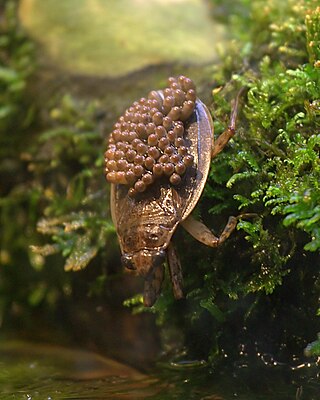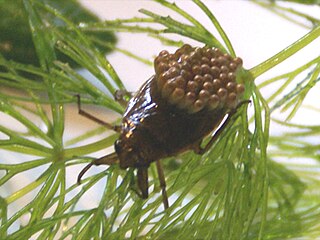
Belostomatidae is a family of freshwater hemipteran insects known as giant water bugs or colloquially as toe-biters, Indian toe-biters, electric-light bugs, alligator ticks, or alligator fleas. They are the largest insects in the order Hemiptera. There are about 170 species found in freshwater habitats worldwide, with more than 110 in the Neotropics, more than 20 in Africa, almost as many in the Nearctic, and far fewer elsewhere. These predators are typically encountered in freshwater ponds, marshes and slow-flowing streams. Most species are at least 2 cm (0.8 in) long, although smaller species, down to 0.9 cm (0.35 in), also exist. The largest are members of the genus Lethocerus, which can exceed 12 cm (4.5 in) and nearly reach the length of some of the largest beetles in the world. Giant water bugs are a popular food in parts of Asia.

Myobatrachidae, commonly known as Australian ground frogs or Australian water frogs, is a family of frogs found in Australia and New Guinea. Members of this family vary greatly in size, from species less than 1.5 cm (0.59 in) long, to the second-largest frog in Australia, the giant barred frog, at 12 cm (4.7 in) in length. The entire family is either terrestrial or aquatic frogs, with no arboreal species.

Lethocerus indicus is a giant water bug in the family Belostomatidae, native to South and Southeast Asia, as well as southeast China, the Ryukyu Islands, and New Guinea. It was originally described as Belostoma indicum but is no longer placed in that genus.
Horvathinia is a small genus in the family Belostomatidae, and the only genus in its subfamily. Though it was originally thought to contain eleven species, upon recent reexamination, the number of species was reduced to two. Horvathinia are incredibly rare and found only in a small part of South America in the border region of Brazil and Argentina. Fewer than 100 specimens of the genus have been collected to date, always at lights at night. It remains unknown what their habits are, where they can be found in the water, what their position in the phylogeny of the water bugs is, or whether they brood their eggs as all other giant water bugs do. Some of these questions are currently being addressed by Argentinian and American entomologists.

Naucoridae is a small family of insects commonly known as the creeping water bugs and saucer bugs. They are similar in appearance and behavior to Belostomatidae, but considerably smaller, at 0.5–2 cm (0.2–0.8 in) long. Naucoridae are found around the world, but the greatest diversity is in tropical regions. They inhabit a wide range of freshwater habitats, ranging from still waters like ponds, to flowing rivers and even torrential streams. There are about 400 species in 46 genera in 8 subfamilies.

Lethocerus deyrollei is a species of giant water bug that traditionally is included in the genus Lethocerus, although recent authorities place it in the monotypic Kirkaldyia. They are large, predatory and nocturnal insects. They are one of the best known giant water bugs and are found in Japan, Korea, east China, east Indochina and the Amur region of Russia. They are very common in much of their range, but have declined drastically in some regions and are considered threatened in Japan and Korea. They live in still waters with vegetation, hatching in the summer months and then overwintering half a year later as adults. They primarily feed on small fish, amphibians and aquatic insects, but have also been recorded taking water snakes and young turtles.

A wasp is any insect of the narrow-waisted suborder Apocrita of the order Hymenoptera which is neither a bee nor an ant; this excludes the broad-waisted sawflies (Symphyta), which look somewhat like wasps, but are in a separate suborder. The wasps do not constitute a clade, a complete natural group with a single ancestor, as bees and ants are deeply nested within the wasps, having evolved from wasp ancestors. Wasps that are members of the clade Aculeata can sting their prey.

Lethocerus is a genus of the hemipteran family Belostomatidae, known colloquially as giant water bugs, toe biters and electric light bugs, distributed in tropical, subtropical and temperate areas of the world. The greatest diversity of species occurs in the Americas, with only a single species in Europe, two in Africa, two in Australia and three in Asia. It includes the largest true bugs with species capable of reaching a length of over 12 centimetres (4.7 in). The South American L. grandis and L. maximus are the only species to commonly exceed 9 cm (3.5 in), with more typical lengths for the remaining species being between 4.5 and 9 cm. Lethocerus sp. are distinguished from other genera in the Lethocerinae by two symmetrical furrows in the inner pad of setae on the fore femur, the external borders of parasternites II and III narrowed and nearly straight, and with the setae of the tarsomeres following the line of the tibial setae.

Lethocerus americanus, sometimes called the electric light bug, toe biter or fish killer, is a giant water bug in the family Belostomatidae, native to southern Canada and the United States. It typically has a length around 5–6 cm (2.0–2.4 in). It was originally classified as a species in genus Belostoma.

Tessaratomidae is a family of true bugs. It contains about 240 species of large bugs divided into 3 subfamilies and 56 genera.

Abedus is a genus of giant water bugs found in freshwater habitats in southern United States, Mexico and Central America. Sometimes called ferocious water bugs, these brown insects typically are between 2.3 and 4 cm (0.9–1.6 in) long, although A. immaculatus only is about 1.3–1.4 cm (0.51–0.55 in), making it the smallest North American belostomatid and possibly worthy of separation in its own genus. Otherwise the different Abedus species are very similar and can often only be separated with a microscope. They will bite in self-defense, which is painful but not dangerous.
In biology, paternal care is parental investment provided by a male to his own offspring. It is a complex social behaviour in vertebrates associated with animal mating systems, life history traits, and ecology. Paternal care may be provided in concert with the mother or, more rarely, by the male alone.
Diplonychus rusticus is an insect native in the Philippines, India, and Australia commonly known as "water bug". This insect lives in shallow waters and feed on aquatic insects including mosquito larvae.

Belostoma flumineum is a North American species of giant water bug. They are a common predator in ponds and wetlands. They are relatively large, reaching 2–2.5 cm (0.79–0.98 in) in length. As with other species of the Belostomatidae family, the fathers take care of the offspring. Exclusive paternal care has been the focus of many studies done on this species. Other studies have been done on food webs and predation pressure using this species because they are an apex predator in their preferred habitats.

Lethocerus insulanus is a species of giant water bug of the family Belostomatidae. Its common name is the Australian giant water bug, but it is also called the electric light bug or giant fishkiller. These names are also used for various other members of the family, including the other Australian species, L. distinctifemur, which is similar to L. insulanus.

Lethocerus patruelis is a giant water bug in the family Belostomatidae. It is native to southeastern Europe, through Southwest Asia, to Pakistan, India and Burma. It is the largest European true bug and aquatic insect. Adult females are typically 7–8 cm (2.8–3.1 in) long, while the adult males are 6–7 cm (2.4–2.8 in).

Belostoma is a genus of insects in the hemipteran family Belostomatidae, known colloquially as giant water bugs. Members of this genus are native to freshwater habitats in the Americas, with the greatest species richness in tropical South America. Most species in the family Belostomatidae have historically been included in Belostoma, but several of these have been moved to other genera. 9 species are claimed to be found in Northern America, but the genus Belostoma is actually divided into 16 subgroups containing about 70 species.

Abedus herberti, the toe biter or ferocious water bug, is a species of giant water bug in the family Belostomatidae. It is native to streams, especially in highlands, in Arizona, New Mexico and Utah in the United States and in northwestern Mexico. Adults are typically 2 to 4 cm (0.8–1.6 in) long. The species is flightless, but may move overland between water sources. It will bite in self-defense, which is painful but not dangerous.

Lethocerus medius is a species of giant water bug in the family Belostomatidae. It is found in Central America from northern Panama north throughout Mexico to southern Arizona, New Mexico, and Texas in the United States, and Cuba, Jamaica, the Cayman Islands, and the Bahamas.

Appasus japonicus is a species of giant water bug in the family Belostomatidae. It is found in Japan and Korea, and has been much studied because it provides an example, rare among insects, of paternal care of the young. With the destruction of its typical habitat and its poor dispersal abilities, it has been listed as being an endangered species in Japan.















